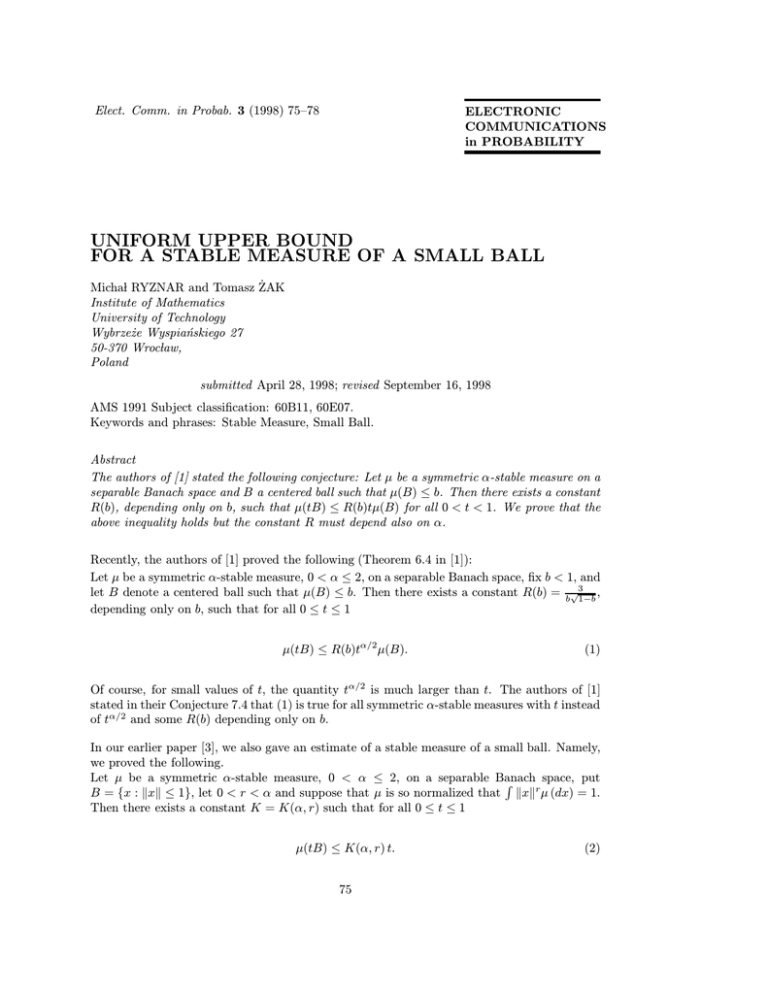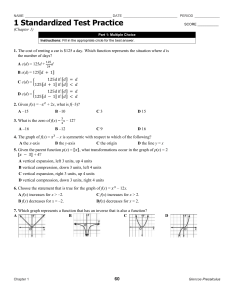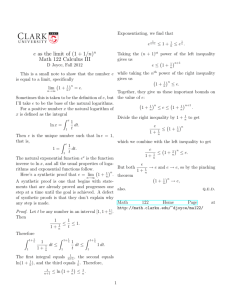UNIFORM UPPER BOUND FOR A STABLE MEASURE OF A SMALL BALL
advertisement

Elect. Comm. in Probab. 3 (1998) 75–78
ELECTRONIC
COMMUNICATIONS
in PROBABILITY
UNIFORM UPPER BOUND
FOR A STABLE MEASURE OF A SMALL BALL
Michal RYZNAR and Tomasz ŻAK
Institute of Mathematics
University of Technology
Wybrzeże Wyspiańskiego 27
50-370 Wroclaw,
Poland
submitted April 28, 1998; revised September 16, 1998
AMS 1991 Subject classification: 60B11, 60E07.
Keywords and phrases: Stable Measure, Small Ball.
Abstract
The authors of [1] stated the following conjecture: Let µ be a symmetric α-stable measure on a
separable Banach space and B a centered ball such that µ(B) ≤ b. Then there exists a constant
R(b), depending only on b, such that µ(tB) ≤ R(b)tµ(B) for all 0 < t < 1. We prove that the
above inequality holds but the constant R must depend also on α.
Recently, the authors of [1] proved the following (Theorem 6.4 in [1]):
Let µ be a symmetric α-stable measure, 0 < α ≤ 2, on a separable Banach space, fix b < 1, and
let B denote a centered ball such that µ(B) ≤ b. Then there exists a constant R(b) = b√31−b ,
depending only on b, such that for all 0 ≤ t ≤ 1
µ(tB) ≤ R(b)tα/2 µ(B).
(1)
Of course, for small values of t, the quantity tα/2 is much larger than t. The authors of [1]
stated in their Conjecture 7.4 that (1) is true for all symmetric α-stable measures with t instead
of tα/2 and some R(b) depending only on b.
In our earlier paper [3], we also gave an estimate of a stable measure of a small ball. Namely,
we proved the following.
Let µ be a symmetric α-stable measure, 0 < α ≤ 2, on a separable Banach
space, put
R
B = {x : kxk ≤ 1}, let 0 < r < α and suppose that µ is so normalized that kxkr µ (dx) = 1.
Then there exists a constant K = K(α, r) such that for all 0 ≤ t ≤ 1
µ(tB) ≤ K(α, r) t.
75
(2)
76
Electronic Communications in Probability
Some estimates of K(α, r) were also given in [3], we recall one of them in the final Remark.
Some normalization of µ is needed, as we
R will show in the sequel (see Example), in the paper
[3] we chose the normalizing condition kxkr µ (dx) = 1. But proving the inequality (2), we
also obtained the inequality
µ(tB) ≤ K(α, r)[1 − µ(B)]−1/r t.
(3)
In this note we will show that using (3) we can prove an estimate that is very close to the
above-mentioned conjecture, however, the constant R(b) must depend also on α.
The following is a generalization of (1).
Theorem 1 Let µ be a symmetric α-stable measure, 0 < α ≤ 2, on a separable Banach space
F . Then for every closed, symmetric, convex set B ⊂ F and for each b < 1 there exists R(α, b)
such that for all 0 ≤ t ≤ 1
µ(tB) ≤ R(α, b) t µ(B),
if µ(B) ≤ b.
(4)
First we show that the constant R must depend on α.
Example. Suppose that there exists positive function R(b) that fulfills (4), does not depend
on α and is bounded on every closed subinterval of (0, 1) Let Xα be an α-stable random
α
variable with the characteristic function e−|t| . It is known (see e.g. [4]) that
1
,
W
d
|Xα |α −→
as α → 0+,
(5)
where W is a random variable having the exponential distribution with mean 1. Consider
one-dimensional ball B = [−1, 1]. From (5) we infer that
bα = P (Xα ∈ B) = P (−1 ≤ Xα ≤ 1) = P (|Xα |α ≤ 1) →α→0 P (
1
1
≤ 1) = .
W
e
Denote by µ the distribution of Xα . It is easy to compute the value of the density of µ at zero:
Z
1 ∞ −tα
1 1
pα (0) =
e
dt = Γ( ).
π 0
π α
Now
1
1
lim lim µ(tB) = lim lim
α→0 t→0+ t
α→0 t→0+ t
Z
t
p(x) dx = lim pα (0) = lim
0
and
lim R(bα ) bα = R
α→0
contradicting the inequality (4).
α→0
1 1
,
e e
α→0
1 1
Γ( ) = ∞,
π α
Stable Measure of a Small Ball
77
This implies that R(b) must also depend on α.
The proof of the theorem is almost the same as the proof of (1) in the paper [1], the difference
is that instead of Kanter inequality we use our estimate (3). For the sake of completeness we
repeat this proof.
We start with two lemmas.
Lemma 1. Let µ be a symmetric α-stable measure, 0 < α ≤ 2, on a separable Banach space
F . Fix 0 < r < α. Then there exists a constant K(α, r) ≥ 2 such that for every convex,
symmetric, closed set B ⊂ F , every y ∈ F and all t ∈ [0, 1] there holds
µ(tB + y) ≤ K(α, r) R t µ(2B + y),
where R = (µ(B))−1 (1 − µ(B))−1/r .
Proof. It is well-known that symmetric stable measures are conditionally Gaussian [2], hence
they satisfy the Anderson property.
Case 1. If y ∈ B then B ⊂ 2B + y so that µ(B) ≤ µ(2B + y), hence by the Anderson property
and (3)
µ(tB + y) ≤
K(α, r)
K(α, r)µ(B)
K(α, r)
t≤
t≤
t µ(2B + y).
(1 − µ(B))1/r
µ(B)(1 − µ(B))1/r
µ(B)(1 − µ(B))1/r
Case 2. If y ∈
/ B then take r = [t−1 − 2−1 ]. Then for k = 0, 1, ..., r the balls {yk + tB} are
disjoint and contained in y + 2B, where yk = (1 − 2tkyk−1 k)y. By the Anderson property
µ(yk + tB) ≥ µ(y + tB) for k = 0, 1, ..., r. Therefore
µ(tB + y) ≤ (r + 1)−1 µ(2B + y) ≤
≤
2t
µ(2B + y)
2−t
K(α, r)
µ(2B + y) t,
(1 − µ(B))1/r
because we assumed that K(α, r) > 2 and 2 − t ≥ 1 > (1 − µ(B))1/r .
Lemma 2. With the same assumptions as in Lemma 1, we have for all 0 ≤ κ, t ≤ 1
µ(κtB) ≤ R0 tµ(κB),
where R0 =
2K(α,r)
.
µ(B/2)(1−µ(B/2))1/r
Proof. For 0 ≤ t ≤ 1 define a measure µt by the formula µt (C) = µ(tC) = P (X/t ∈ C), where
X is a symmetric α-stable random variable with the distribution µ. Then µt is also α-stable
and we have the following equality:
µ ∗ µs (C) = P (X + X 0 /s ∈ C) = P ((1 + s−α )1/α X ∈ C) = µt (C),
where t = (1 + s−α )−1/α and X 0 is an independent copy of X. Now by Lemma 1
Z
2κB
µ(κ(tB)) = µ(t(κB)) = P (X/t ∈ κB) = µ ∗ µs (κB) =
µ(
+ y)µs (dy)
2
F
78
Electronic Communications in Probability
≤
K(α, r)2κ
2K(α, r)
µt (B) =
κµ(tB).
µ(B/2)(1 − µ(B/2))1/r
µ(B/2)(1 − µ(B/2))1/r
Proof of the Theorem. Fix B with µ(B) ≤ b and take s ≥ 1 such that µ(sB) = b. Now, in
1
Lemma 2, put κ = t and t = 2s
. Then
µ(tB) = µ(t ·
1
1
K(α, r)2
· (2sB)) ≤ t
µ( · 2sB) ≤
2s
µ(sB)(1 − µ(sB))1/r 2s
K(α, r)2
t µ(B) = R(b)K(α, r)t µ(B),
µ(sB)(1 − µ(sB))1/r
where R(b) = 2b−1 (1 − b)−1/r . Taking different values of r ∈ (0, α) we get different values of
K(α, r). If, for simplicity, we take r = α/2 we get R(α, b) = K(α, α/2) b(1−b)21−α/2 . This ends
the proof of the theorem.
Remark. Let us recall some estimates of K(α, r) which were given in the paper [3]. If we
take r = α/2 then
K(α,
2 α
1
α
1
1
2
) = 1/α √ Γ α ( + )Γ(1 + ) inf 2/α
,
2
4
2
α x>0 x (1 − Φ(x))
2
π
where Φ is the distribution function of a standard normal variable. For different values of
r other estimates are possible, it could be interesting to find the least value of K(α, r). Of
course, if we consider α ≥ ε > 0 then we can find
R(b) = sup R(α, b) < ∞
ε≤α≤2
and then for all 0 ≤ t ≤ 1 and α ≥ ε
µ(tB) ≤ R(b) t µ(B),
if µ(B) ≤ b.
References
[1] P. Hitczenko, S. Kwapien, W.N. Li, G. Schechtman, T. Schlumprecht and J. Zinn: Hypercontractivity and comparison of moments of iterated maxima and minima of independent
random variables, Electronic J. of Probab. 3 (1998), 1–26.
[2] R. LePage, M. Woodroofe and J. Zinn: Convergence to a stable distribution via order
statistics, Ann. Probab. 9/4 (1981), 624–632. MR82k:60049
[3] M. Lewandowski, M. Ryznar and T. Zak: Stable measure of a small ball, Proc. Amer.
Math. Soc. 115/2 (1992), 489–494. MR92i:60004
[4] N. Cressie: A note on the behaviour of the stable distribution for small index alpha, Z.
Wahrscheinlichkeitstheorie verw. Gebiete, 33 (1975), 61–64. MR52:1825







